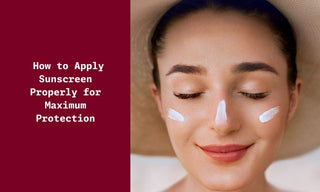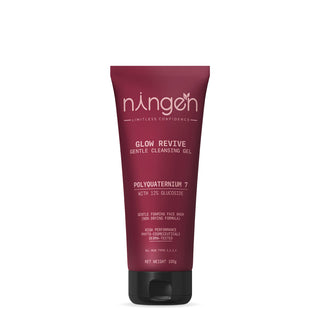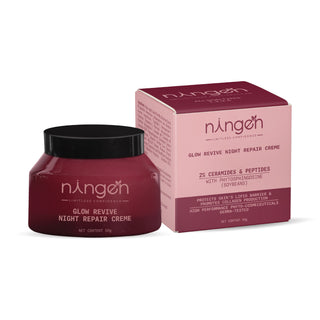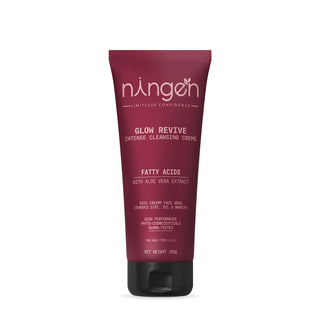सनस्क्रीन हर स्किनकेयर का एक इम्पोर्टेन्ट स्टेप है, लेकिन कई बार हम इसे ज़रूरी नहीं समझ कर स्किप कर देते है या इसे ठीक तरह से अप्लाई नहीं करते है। चाहे हम बीच पर हों, धूप में घूम रहे हों या बस विंडो की पास बैठें हों, आपकी स्किन हमेशा UV रेयज के एक्सपोज़र में होती है, जो बढ़ते समय के साथ आपकी स्किन को डैमेज कर सकती है। सनस्क्रीन को सही तरीके से लगाना ज़रूरी है, ताकि आपकी स्किन को वो प्रोटेक्शन मिले जो उसे प्रीमैच्योर एज़िंग, सनबर्न और स्किन कैंसर से बचाए। इस ब्लॉग में, हम आपको बताएंगे कि सनस्क्रीन को कैसे सही तरीके से अप्लाई करें, ताकि आप मैक्सिमम प्रोटेक्शन ले सकें और पूरे साल अपनी स्किन को हेल्दी और ग्लोइंग बना सकें ।
In This Article;
- 1. नारियल तेल: नेचर का मोइस्चराइजर
- 2. कैस्टर तेल: सबसे बेहतरीन कंडीशनर
- ब्रॉड - स्पेक्ट्रम vs नॉन - ब्रॉड - स्पेक्ट्रम संस्क्रीन्स
- सनस्क्रीन क्रीम कैसे लगाएं अलग-अलग बॉडी पार्ट्स पर?
- सनस्क्रीन को कब और कितनी बार फिर से लगाना चाहिए
- निष्कर्ष
- अंतिम जानकारी
- अक्सर पूछे जाने वाले प्रश्न
1. नारियल तेल: नेचर का मोइस्चराइजर
सनस्क्रीन आपकी स्किन को स्वस्थ बनाए रखने और खतरनाक UV रेयज से होने वाले नुकसान से बचाने के लिए बेहद ज़रूरी है। यह एक सुरक्षा कवच की तरह काम करता है, जो आपकी स्किन को सनबर्न, प्रीमैच्योर एजिंग, और यहां तक कि स्किन कैंसर से भी बचाता है। सनस्क्रीन एक प्रोटेक्टिव बैरियर बना कर डार्क स्पॉट्स, झुर्रियां और सूरज से स्किन को होने वाले नुकसान को रोकता है। चाहे बादल हों या तेज धूप, रोज़ाना सनस्क्रीन का इस्तेमाल लंबे समय तक स्किन सुरक्षा और स्वास्थ्य के लिए ज़रूरी है। सनस्क्रीन को प्राथमिकता देने से आपकी स्किन न केवल ग्लोइंग रहती है, बल्कि यह पर्यावरणीय तनाव से भी सुरक्षा प्रदान करता है।
हार्मफुल यू वी रेज़ से प्रोक्शन के लिए, ऐसे अप्लाई करें सनस्क्रीन
सही तरीके से सनस्क्रीन लगाने के लिए अपनी स्किन को तैयार करना ज़रूरी है। सनस्क्रीन अच्छी तरह से आपकी स्किन पर काम करे और स्किन को फ़ायदा पहुँचाये इसके लिए सबसे पहले अपनी स्किन को अच्छे से तैयार करें। इस गाइड में हम आपको बतायेगें की आप अपनी स्किन को सनस्क्रीन के लिए कैसे तैयार करें, ताकि आपकी स्किन पर सनस्क्रीन अच्छे से काम करें।
- चेहरे को अच्छे से धोएं
सबसे पहले, अपने चेहरे को हल्के क्लेंजर से धोएं जो आपकी स्किन टाइप के अनुसार हो। इस स्टेप से गंदगी, तेल और इम्पुरिटीज़ हट जाएंगी जो सनस्क्रीन के अब्सॉर्प्शन में रुकावट डाल सकती हैं। गुनगुने पानी का इस्तेमाल करें, ज्यादा रगड़ने से बचें, जो स्किन को इरिटेट कर सकता है।
- टोनिंग करें
चेहरे को धोने के बाद, एक अच्छा फेस टोनर लगाएं जो आपकी स्किन के pH लेवल को बैलेंस करता है और बचे हुए अशुद्धियाँ हटा देता है। टोनिंग से आपके पोर्स टाइट होते हैं और स्किन अगले प्रोडक्ट्स के लिए तैयार होती है। ऐल्कोहल-फ्री टोनर का चुनाव करें ताकि आपकी स्किन सूखने न पाए, खासकर अगर आपकी स्किन सेंसिटिव या ड्राई है।
- सनस्क्रीन लगाने से पहले स्किन को मॉइस्चराइज़ करें
टोनिंग के बाद, अपनी स्किन को हाइड्रेटेड रखने के लिए एक अच्छा मॉइस्चराइज़र लगाएं। यह स्टेप इसलिए ज़रूरी है क्योंकि यह सनस्क्रीन के लिए एक स्मूद बेस तैयार करता है, जिससे वह समान रूप से फैलता है और कोई सफेद धब्बा नहीं छोड़ता। ऑयली स्किन के लिए हल्का, ऑयल-फ्री मॉइस्चराइज़र सबसे अच्छा है, जबकि ड्राई स्किन के लिए फॉर्मुलेशन मॉइस्चराइज़र फायदेमंद हो सकता है।
सही अमाउंट में सनस्क्रीन यूज़ करना है ज़रूरी
सन्सक्रीन का सही मात्रा लगाना बहुत ज़रूरी है ताकि आपकी त्वचा को सही सुरक्षा मिले। अगर आप अपने चेहरे पर सन्सक्रीन लगा रहे हैं, तो एक निकेल साइज का अमाउंट काफी होता है। इससे आपकी त्वचा को यू वी(UV) किरणों से प्रोटेक्शन मिलता है।
टू-फिंगर मेथड क्या है?
टू-फिंगर मेथड एक साधारण तरीका है जिससे आप आसानी से सन्सक्रीन की सही मात्रा लगा सकते हैं। यह कैसे काम करता है:
- अपने इंडेक्स और मिडल फिंगर के बेस से टिप तक सन्सक्रीन लें ।
- यह अमाउंट अपने चेहरे और गर्दन पर लगाएं ताकि अच्छी कवरेज मिले।
यह मेथड आपको सन्सक्रीन लगाते समय मात्रा को मापे बिना सही अमाउंट लगाने में मदद करता है, जिससे आप अपनी त्वचा को UV किरणों से अच्छे से सुरक्षित रख पाते हैं।
2. कैस्टर तेल: सबसे बेहतरीन कंडीशनर
सन्सक्रीन प्रोडक्ट दो टाइप के होते हैं, जो उनके एक्टिव इंग्रीडिएंट्स और स्किन की सुरक्षा के तरीके पर डिपेंड होते हैं:
फिजिकल (मिनरल) सन्सक्रीन:
इंग्रीडिएंट्स : ज़िंक ऑक्साइड या टाइटेनियम डाइऑक्साइड।
कैसे काम करता है: ये स्किन पर एक फिजिकल बैरियर बनाते हैं जो हानिकारक UV किरणों को वापस मोड़ (परावर्तित) देता है।
फायदे: सेंसिटिव स्किन के लिए आदर्श, लगाने के बाद तुरंत सुरक्षा शुरू होती है, और पोर्स के ब्लॉक होने के चांसेस कम होते है।
नुकसान: यह खासकर डार्क स्किन टोन पर व्हॉइटकास्ट छोड़ सकता है।
केमिकल सन्सक्रीन:
इंग्रीडिएंट्स : अवोबेंजोने, ऑक्टिनोक्सेट, ऑक्सीबेंजोने और भी
कैसे काम करता है: यह UV किरणों को सोख लेता है है और उन्हें गर्मी में बदल देता है, जो फिर त्वचा से बाहर निकल जाती है।
फायदे: हल्का, बिना व्हॉइटकास्ट छोड़े आसानी से स्किन में मिल जाती है, और रोज़ाना इस्तेमाल के लिए अच्छा होता है।
नुकसान: यह सेंसिटिव स्किन को इर्रिटेट कर सकता है और सूरज की रोशनी में जाने से पहले 20-30 मिनट इंतजार करना पड़ता है।
दोनों प्रकार के सन्सक्रीन अलग - अलग फोम्स में बाज़ार में मिलता हैं, जैसे लोशन, क्रीम, स्प्रे, स्टिक्स, और जेल, जो अलग-अलग स्किन की जरूरतों के हिसाब से यूज़ किए जा सकते हैं।
ब्रॉड - स्पेक्ट्रम vs नॉन - ब्रॉड - स्पेक्ट्रम संस्क्रीन्स
SPF ब्रोड-स्पेक्ट्रम सनस्क्रीन UVA और UVB दोनों रेज़ (किरणों) से सुरक्षा देते हैं। UVA रेज़ प्रीमैच्योर एजिंग और स्किन कैंसर का कारण होती हैं, जबकि UVB रेज़ सनबर्न का कारण होती हैं। ब्रोड-स्पेक्ट्रम सनस्क्रीन आपको डार्क स्पॉट्स, झुर्रियां, और दूसरी सन डेमेज से बचाता है। नॉन-ब्रोड-स्पेक्ट्रम सनस्क्रीन सिर्फ UVB रेज़ से बचाते हैं, जो सनबर्न तो होता है लेकिन गहरे स्किन डैमेज नहीं करता। सबसे अच्छा प्रोटेक्शन के लिए हमेशा ब्रोड-स्पेक्ट्रम सनस्क्रीन चुनें, ताकि आपको हानिकारक रेज़ से पूरी सुरक्षा मिल सके।
SPF रेटिंग्स और उनकी इम्पोर्टैंट्स
SPF (सन प्रोटेक्शन फैक्टर) यह बताता है कि सनस्क्रीन UVB रेज़ से कितना प्रोटेक्शन देता है। ज्यादा SPF रेटिंग्स ज्यादा प्रोटेक्शन ऑफर करती हैं। डेली यूज़ के लिए SPF 30 या उससे ज्यादा रेकमंडेड है, जो लगभग 97% UVB रेज़ से सुरक्षा देता है। अगर आप आउडडोर एक्टिविटीज़ कर रहे हैं, तो SPF 50 या उससे ज्यादा का सनस्क्रीन यूज़ करें। लेकिन ध्यान रहे, कोई भी सनस्क्रीन 100% UV रेज़ को ब्लॉक नहीं कर सकती । SPF की प्रभावशीलता सही एप्लिकेशन और रीएप्लिकेशन पर डिपेंड करती है, खासकर अगर आप स्विमिंग या पसीना बहा रहे हैं।
सनस्क्रीन क्रीम कैसे लगाएं अलग-अलग बॉडी पार्ट्स पर?
सनस्क्रीन का सही तरीके से लगाना जरूरी है ताकि आपकी त्वचा UV डैमेज से सुरक्षित रह सके। हर बॉडी पार्ट के लिए अलग तकनीक फॉलो करें।
चेहरा और गर्दन: चेहरे पर एक निकेल-साइज़ (सिक्के के आकार) मात्रा ब्रोड-स्पेक्ट्रम सनस्क्रीन लगाएं। अच्छे से स्प्रेड करें, हेयरलाइन, कान और जॉ लाइन के नीचे भी कवर करें। गर्दन पर भी अच्छे से लगाएं और ऊपर की ओर स्ट्रोक्स में अप्लाई करें।
बॉडी: पूरी बॉडी के लिए शॉट ग्लास-साइज़ (शॉट ग्लास की मात्रा) सनस्क्रीन का इस्तेमाल करें। ऐसे एरिया पर ज्यादा ध्यान दें जो मिस हो जाते हैं, जैसे पैरों के ऊपर, घुटनों के पीछे और गर्दन। हर दो घंटे में रीएप्लाई करें या स्विमिंग/पसीना बहाने के बाद सनस्क्रीन फिर से लगाएं। अपनी स्किन टाइप के हिसाब से सनस्क्रीन चुनें ताकि बेहतरीन रिजल्ट्स मिलें। और हमेशा अपने डेली रूटीन में सनस्क्रीन को शामिल करें, चाहे धूप हो या बारिश।
सनस्क्रीन को कब और कितनी बार फिर से लगाना चाहिए
सबसे पहले सुबह अपने रूटीन का हिस्सा बनाते हुए सनस्क्रीन लगाएं, लेकिन ध्यान रखें कि इसका इम्पैक्ट समय, नमी और हवा के साथ कम होता जाता है। आपकी स्किन टोन से कोई फर्क नहीं पड़ता, कोशिश करें कि हर दो घंटे में सनस्क्रीन फिर से लगाएं। ब्रोड-स्पेक्ट्रम SPF चुनें और पूरा कवरेज के लिए SPF लिप बाम न भूलें। सनस्क्रीन के साथ - साथ फुल कवरेज कपड़े भी पहने, ताकि आपकी त्वचा को अधिकतम सुरक्षा मिल सके।
हर दो घंटे में सनस्क्रीन को रीअप्लाई करना सन डैमेज से बचाव के लिए बेहद जरूरी है, खासकर जब आप बाहर हों, आप स्विमिंग कर रहे हो या पसीना बहा रहे हो, तो अपनी बॉडी को तौलिया से सुखाने के बाद सनस्क्रीन वापस से अप्लाई करें ।
रोज़ाना सनस्क्रीन के उपयोग के फायदे त्वचा की सेहत के लिए
- आपकी त्वचा को UVA और UVB रेज़ के हानिकारक प्रभाव से सुरक्षित रखता है
- प्रीमैच्योर एजिंग, डार्क स्पॉट्स और फाइन लाइन्स से बचाता है
- स्किन कैंसर के रिस्क को कम करता है
- सभी प्रकार की त्वचा (ऑइली और सेंसिटिव दोनों) के लिए बेस्ट है
- समान स्किन टोन बनाए रखने में मदद करता है
- सनबर्न और सन डैमेज से बचाता है
- लम्बे समय तक स्किन को हेल्थी और युथफुल अपीयरेंस को सपोर्ट करता है
निष्कर्ष
प्रीमैच्योर एजिंग, सनबर्न को रोकने से लेकर स्किन कैंसर के रिस्क को कम करने तक, अपने डेली स्किनकेयर रूटीन में सनस्क्रीन को शामिल करना एक सबसे इम्पोर्टेन्ट स्टेप्स में से एक है। सनस्क्रीन हार्मफुल (हानिकारक) UV रेज़ से आवश्यक सुरक्षा देता है। चाहे आप फिजिकल या केमिकल सनस्क्रीन पसंद करें, सुनिश्चित करें कि आप एक ब्रोड-स्पेक्ट्रम प्रोडक्ट चुनें जो आपकी त्वचा के प्रकार के लिए उपयुक्त SPF प्रदान करता हो। सही मात्रा में सनस्क्रीन लगाएं, दिन भर में इसे रीअप्लाई , और प्रोटेक्टिव कपड़े पहनें।
अंतिम जानकारी
सनस्क्रीन आपकी त्वचा को UV रेज़, प्रीमैच्योर एजिंग और स्किन कैंसर से बचाने के लिए जरूरी है। अधिकतम सुरक्षा सुनिश्चित करने के लिए सनस्क्रीन लगाने से पहले अपनी त्वचा को धोकर, टोन और मॉइस्चराइज करें। सही अमाउंट मापने के लिए "टू-फिंगर मेथड" का उपयोग करें, और हर दो घंटे में इसे फिर से लगाना न भूलें। अपनी स्किन टाइप के अनुसार सनस्क्रीन चुनें और इसे प्रोटेक्टिव कपड़े पहनें। सनस्क्रीन को अपने रोज़ाना स्किनकेयर रूटीन का हिस्सा बनायें, चाहे धूप हो या बारिश।
अक्सर पूछे जाने वाले प्रश्न
- मुझे चेहरे पर कितनी सनस्क्रीन लगानी चाहिए?
चेहरे और गर्दन को अच्छे से कवर करने के लिए लगभग एक निकेल-साइज़ मात्रा का उपयोग करें।
- टू-फिंगर मेथड" क्या है?
यह सनस्क्रीन को दो अंगुलियों (इंडेक्स और मिडल) पर निचोड़कर चेहरे और गर्दन के लिए सही मात्रा मापने का तरीका है।
- मुझे कितनी बार सनस्क्रीन री - अप्लाई करनी चाहिए?
हर 2 घंटे में या पसीना बहने के बाद तुरंत सनस्क्रीन फिर से लगाएं।
- क्या मैं अपने चेहरे और शरीर पर एक ही सनस्क्रीन इस्तेमाल कर सकता हूँ?
जी हां, लेकिन चेहरे के सनस्क्रीन अक्सर ज्यादा सेंसिटिव स्किन के लिए तैयार किए जाते हैं और इनकी टेक्सचर हल्की होती है।
- क्या बादल वाले दिनों में भी सनस्क्रीन जरूरी है?
जी हां, बादलों के जरिए 80% UV रेज़ penetrates कर सकती हैं, इसलिए साल भर सनस्क्रीन का उपयोग जरूरी है।
- फिजिकल और केमिकल सनस्क्रीन में क्या अंतर है?
फिजिकल सनस्क्रीन UV रेज़ को ब्लॉक और रिफ्लेक्ट करता है, जबकि केमिकल सनस्क्रीन उन्हें अवशोषित करके हीट में बदलता है।
- क्या डार्क स्किन होने पर भी सनस्क्रीन की आवश्यकता है?
जी हां, हर किसी को सनस्क्रीन लगानी चाहिए, चाहे उनकी त्वचा का रंग कोई भी हो, UV रेज़ से सुरक्षा की जरूरत होती है ताकि त्वचा का नुकसान और कैंसर से बचाव हो सके।
- क्या ज्यादा SPF ज्यादा सुरक्षा देता है?
ज्यादा SPF आपकी त्वचा को ज्यादा सुरक्षा देता है, लेकिन कोई भी सनस्क्रीन 100% UV रेज़ को ब्लॉक नहीं कर सकता। सामान्यत: SPF 30 रोज़ाना यूज़ के लिए एक अच्छा ऑप्शन है।
- क्या सनस्क्रीन झुर्रियों और फाइन लाइन्स को रोक सकता है?
जी हां, सनस्क्रीन UV डैमेज से सुरक्षा प्रदान करता है, जो प्रीमैच्योर एजिंग और झुर्रियों का प्रमुख कारण है।
- सनस्क्रीन लगाने का सही तरीका क्या है?
सनस्क्रीन को प्रभावी रूप से लगाने के सामान्य तरीका इस प्रकार हैं:
सही मात्रा का उपयोग करें:
अपने चेहरे के लिए लगभग एक निकेल-साइज़ (लगभग 1.5 ग्राम) मात्रा लगाएं।
अपने शरीर के लिए लगभग एक औंस (शॉट ग्लास के आकार के बराबर) सनस्क्रीन का उपयोग करें, ताकि सभी एक्सपोज़्ड एरिया कवर हो जाएं।
धूप से पहले लगाएं:
सनस्क्रीन को बाहर जाने से 15-30 मिनट पहले लगाएं। इससे यह अच्छी तरह से अब्सॉर्ब होकर अधिकतम सुरक्षा प्रदान करता है।
समान रूप से लगाएं:
सनस्क्रीन को सभी एक्सपोज़्ड स्किन पर समान रूप से लगाएं, जिसमें अक्सर मिस हो जाने वाले स्थान जैसे कान के ऊपर, गर्दन का पिछला हिस्सा और पैरों के ऊपर शामिल हैं।
नियमित रूप से फिर से लगाएं:
हर दो घंटे में सनस्क्रीन को फिर से लगाएं, या स्विमिंग या पसीना बहाने के बाद, यहां तक कि वाटर-रेसिस्टेंट फॉर्मूला होने पर भी।
ब्रोड-स्पेक्ट्रम चुनें:
ब्रोड-स्पेक्ट्रम सनस्क्रीन का चयन करें, जो UVA और UVB दोनों रेज़ से सुरक्षा प्रदान करता है।
SPF चेक करें:
कम से कम SPF 30 वाले सनस्क्रीन का चयन करें, जो लगभग 97% UVB रेज़ को ब्लॉक करता है।
अन्य सुरक्षा उपाय न भूलें:
सनस्क्रीन का उपयोग प्रोटेक्टिव कपड़े, हैट्स और सनग्लासेज़ के साथ करें, ताकि आपकी त्वचा की सुरक्षा बढ़ सके।
- मेकअप पर सनस्क्रीन कैसे लगाएं?
मेकअप को बिना खराब किए सनस्क्रीन फिर से लगाने के लिए सनस्क्रीन स्प्रे या पाउडर सनस्क्रीन का उपयोग करें।












